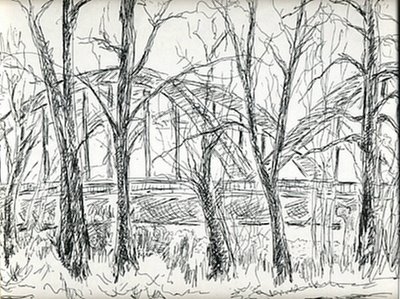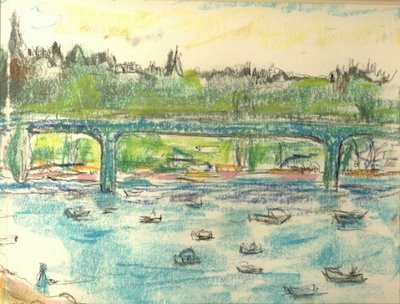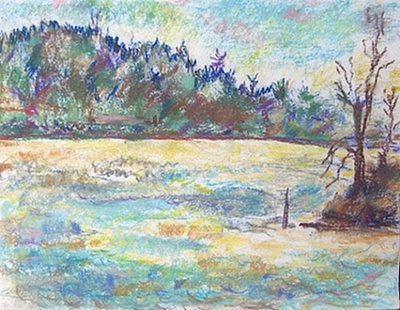Chapter 9: At the water's edge
I am returning us now to landscapes, but of a particular sort. For the most part, I doubt if they were done as part of a group undertaking with her artist friends. Their style is more individual, no longer bound by the group spirit.
First let us see two pencil drawings I suspect were done at Chatco, a camp for adults in Idaho (11-b). They both have a “summer camp” feel. A xerox of the first has the year “1994” after her initials. The back of the second has the words “near Coeur d’Alene, Idaho.” Both are on 8.5 by 11 inch paper.


Chatco was a happy place for Mom. Diane Marsden, who traveled around Europe with her, told me how they met there. They were putting on a skit dressed up as hoboes, with Chatco as the hobo camp. Something about Mom that immediately caught Diana’s eye, and despite the age difference between them, they were friends from then on. This past summer, when Diana of course had no idea Mom was dying—none of us did—she told the newcomers at Chatco how one can make friends for life there, giving her friendship with Mom as her example. She sang the song “A love affair to remember” in Mom’s honor.
My next series of Mom’s pieces comes from what would become her favorite place to sketch, to the end of her life. The first one (11c) is of the highway bridge on US Route 99E, also known as McLoughlin Boulevard, over the Clackamas River, as seen from the Oregon City side of the river. There is a little park there, Clackamette Park, and parking places, ideal for sketching. The next one (11d) shows the same bridge done in oils. The words “Dream Bridge” and “1994” are written on the back. These are only two of numerous depictions of this bridge done between 1990 and 2005.


Another bridge is prominent at this location, seen in the next two (11e-f). This one is the I-205 bridge over the Willamette. In her numerous sketches with this bridge, it usually is in the background, the foreground taken up by fishing boats. The best fishing is from April through June, when the salmon come upriver to spawn. The salmon probably congregate here a while before either turning left and going up the Clackamas, or braving Willamette Falls ahead of them. Mom sketched the boats in all sorts of ways, but always with not much detail. In the second sketch (11f) they are just smudges, the extreme of abstraction; in the background the green bridge blends in with the trees.


In wintertime the boats went away and the floodwaters came, carrying logs, soil, and other debris with them. Mom was there sketching what she must have seen as an avoidable waste of precious resources. She painted the river as though it were sick from eating too much 11g). Mom was not always after a pretty picture. Truth was more important.

Mom was also interested in the people on the shore. Some people fished from the river’s edge. I never saw one catch a fish, in contrast to the people in the boats, but they seemed to be having a good time. Mom sketched them in a variety of poses—-characteristically, this one is from behind (11h).

Other people came to the park, too. No longer drawing a model in a studio, Mom portrayed them as they came and went. These next two (11i-j) were probably drawn in one of two parks bordered by the Clackamas and Willamette Rivers. The second one (11j)is of her granddaughter Melissa at a young age. Again characteristically, it is from the back—not exactly what her parents would have wanted to treasure as a grandmother’s portrait of her granddaughter. But Mom gave lots to treasure anyway.


I will end this chapter with two versions of the same scene, in monochrome and color (11k, 11l). This is something Mom did occasionally, to good effect, even at the end of her life. I have no idea where they were done. There is a building on the opposite shore. Perhaps it is Chatco. Or it could be somewhere the “pleine aire” group went. It is in the same sketchbook as her Sauvie Island sketches done with that group, and in the same style. But neither Sauvie Island nor the opposite bank has hills like that.


First let us see two pencil drawings I suspect were done at Chatco, a camp for adults in Idaho (11-b). They both have a “summer camp” feel. A xerox of the first has the year “1994” after her initials. The back of the second has the words “near Coeur d’Alene, Idaho.” Both are on 8.5 by 11 inch paper.


Chatco was a happy place for Mom. Diane Marsden, who traveled around Europe with her, told me how they met there. They were putting on a skit dressed up as hoboes, with Chatco as the hobo camp. Something about Mom that immediately caught Diana’s eye, and despite the age difference between them, they were friends from then on. This past summer, when Diana of course had no idea Mom was dying—none of us did—she told the newcomers at Chatco how one can make friends for life there, giving her friendship with Mom as her example. She sang the song “A love affair to remember” in Mom’s honor.
My next series of Mom’s pieces comes from what would become her favorite place to sketch, to the end of her life. The first one (11c) is of the highway bridge on US Route 99E, also known as McLoughlin Boulevard, over the Clackamas River, as seen from the Oregon City side of the river. There is a little park there, Clackamette Park, and parking places, ideal for sketching. The next one (11d) shows the same bridge done in oils. The words “Dream Bridge” and “1994” are written on the back. These are only two of numerous depictions of this bridge done between 1990 and 2005.


Another bridge is prominent at this location, seen in the next two (11e-f). This one is the I-205 bridge over the Willamette. In her numerous sketches with this bridge, it usually is in the background, the foreground taken up by fishing boats. The best fishing is from April through June, when the salmon come upriver to spawn. The salmon probably congregate here a while before either turning left and going up the Clackamas, or braving Willamette Falls ahead of them. Mom sketched the boats in all sorts of ways, but always with not much detail. In the second sketch (11f) they are just smudges, the extreme of abstraction; in the background the green bridge blends in with the trees.


In wintertime the boats went away and the floodwaters came, carrying logs, soil, and other debris with them. Mom was there sketching what she must have seen as an avoidable waste of precious resources. She painted the river as though it were sick from eating too much 11g). Mom was not always after a pretty picture. Truth was more important.

Mom was also interested in the people on the shore. Some people fished from the river’s edge. I never saw one catch a fish, in contrast to the people in the boats, but they seemed to be having a good time. Mom sketched them in a variety of poses—-characteristically, this one is from behind (11h).

Other people came to the park, too. No longer drawing a model in a studio, Mom portrayed them as they came and went. These next two (11i-j) were probably drawn in one of two parks bordered by the Clackamas and Willamette Rivers. The second one (11j)is of her granddaughter Melissa at a young age. Again characteristically, it is from the back—not exactly what her parents would have wanted to treasure as a grandmother’s portrait of her granddaughter. But Mom gave lots to treasure anyway.


I will end this chapter with two versions of the same scene, in monochrome and color (11k, 11l). This is something Mom did occasionally, to good effect, even at the end of her life. I have no idea where they were done. There is a building on the opposite shore. Perhaps it is Chatco. Or it could be somewhere the “pleine aire” group went. It is in the same sketchbook as her Sauvie Island sketches done with that group, and in the same style. But neither Sauvie Island nor the opposite bank has hills like that.



0 Comments:
Post a Comment
<< Home